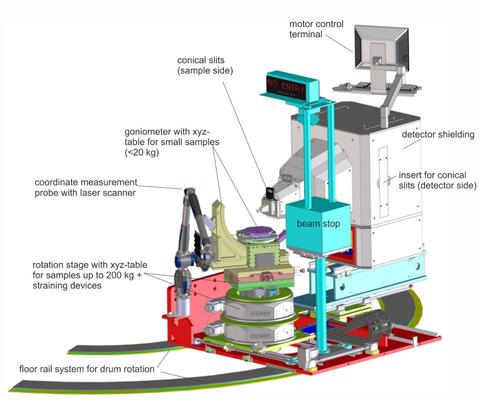BT-8 Diffractometer for Stress and Texture
The BT-8 diffractometer supports primarily the engineering research needs of users from federal agencies, academia, and the American industry. The main areas of research are residual stresses in structural materials, the measurement of applied stresses during multiaxial straining, and preferred orientation and phase composition as a result of materials processing. Materials of interest are high-strength alloys used in additive manufacturing, steels for naval and automotive applications, and weld-induced stresses in structural materials.
Stresses are determined from the measurement of elastic changes of interatomic lattice spacings at depths up to several centimeters, and with spatial resolutions of the order of » 1 millimeter. Spatial resolution is determined by the dimensions of the incident and diffracted neutron beams, both of which are set through apertures or slits. Lattice spacings change linearly with stress, which itself is both directional and generally dependent on the location in a specimen. Therefore, the determination of tri-axial stresses for a given location in the sample requires different orientations of the sample.
Instrument features
The upgrade of all BT8 core components has been completed. The instrument now features a large, high-pressure, 10 bar 3He area detector, single and multi-wavelength Si-crystal monochromators with variable curvature, two multi-axial high-capacity straining devices, separate sample stages for small and large samples, and a digital image correlation system for the measurement of plastic strain during multiaxial loading. A phi-chi goniometer with XYZ table serves both as sample positioning stage and as sample changer for high-throughput texture measurements. A coordinate measurement probe is available for aligning samples with complicated or irregular shapes.

The modular instrument design allows for a large degree of flexibility with respect to measurable diffraction peaks, wavelengths, diffraction angles, gauge volumes, and specimen size. Gauge volumes can be defined through primary/secondary apertures (single peak measurement) or using conical slits for measurements that use multiple peaks. Large (» 0.6 m) and heavy samples are positioned and oriented using the base goniometer with the possibility of reducing the weigh-on-table through the load-balancing instrument jib crane. Small specimens (< 300 mm) can be positioned and oriented without re-mounting using a Eulerian cradle with integrated XYZ positioning table. The Euler cradle together with a sample changer can be used for fast measurement of both complete pole figures and phase composition.
Sample environment
Sample environment options focus on lattice strain measurements under applied stress both in uniaxial and in multi-axial deformation. Mechanically actuated load frames allow uniaxial loads up to 100 kN. Multi-axial deformations are facilitated through two devices: a shear device allows straining in various modes including simple and pure shear up to 30 kN of applied force. The Octo-strain eight arm device was designed for complex strain paths in the deformation of high-strength steels through eight individually controlled actuators. Both devices can be rotated, thus enabling the determination of the principal stress axes. A key feature of multi-axial deformation is that the spatial distribution of both plastic strains and stresses is inhomogeneous, that is, both depend on the location. Thus, it is crucial that plastic strains at the locations of the neutron measurement are known. This is accomplished through a digital image correlation (DIC) system.
The combination of plastic strain data (DIC) and true stresses (neutron diffraction) produces stress-strain relationships necessary for the prediction of material behavior in sheet metal forming.
Specifications/Capabilities
|
|
Min |
Max |
|
Take-off angle |
50 ° |
100 ° |
|
Detector angle |
40 ° |
110 ° |
|
Wavelength range (continuous) |
0.0937 nm |
0.2509 nm |
|
Lattice spacings range |
0.541 nm |
0.367 nm |
|
Distance monochromator-sample |
1200 mm |
1600 mm |
|
Large sample table travel range |
X: 300 mm Y: 300 mm Z: 360 mm Rotation: 360 ° |
|
|
Small sample Euler cradle (travel, angle range) |
X:150 mm Y: 150 mm Z: 150 mm Phi: 360 ° Chi: 90 ° |
|
|
Max. large sample weight |
250 kg |
|
|
Max. small sample weight |
10 kg |
|
|
Dimensions of the neutron-sensitive detector area |
250 mm (w) x 380 mm (h) |
|
|
Detector vertical angular coverage |
20 ° |
30 ° |
|
Detector horizontal angular coverage |
15 ° |
20 ° |
|
Local jib crane capacity (load balancing) |
250 kg |
|

